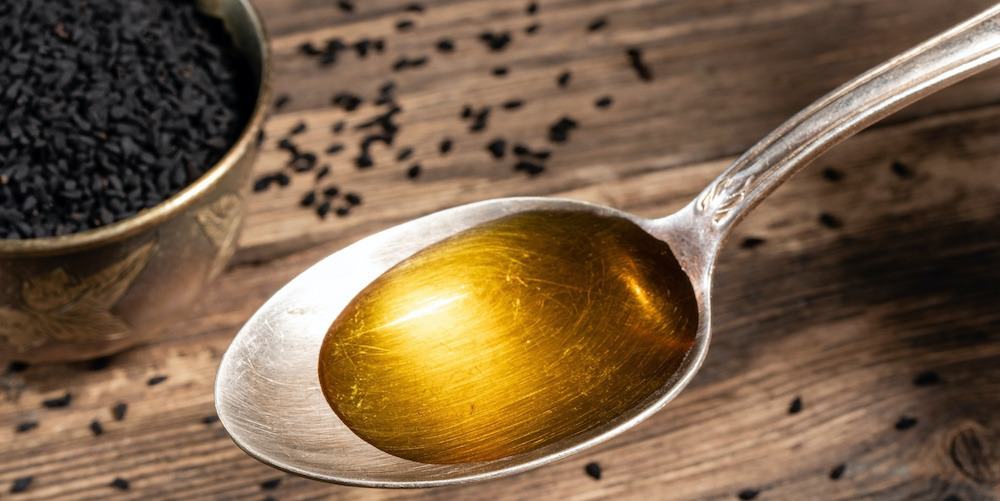BENEFITS OF BLACK CUMIN
✓ Protects and stimulates the body
✓ Reduces inflammation
✓ Fights bacteria
✓ Improves diabetes
✓ Relieves skin conditions
What is black cumin?
Native to southwestern Asia, black cumin (Nigella sativa) is a plant belonging to the Ranunculaceae family, like anemones and clematis. Here, we will discuss Nigella sativa and not Nigella damascena, or love-in-a-mist, an ornamental plant whose seeds are toxic.
The name “black cumin” comes from its Latin roots “nigellus” or “niger” meaning “black” in reference to the color of its seeds. Once the flowers have withered, Nigella sativa produces numerous edible seeds commonly used as a spice, earning it the nickname “black cumin.”
The seeds have a pungent and peppery flavor. They are typical of Eastern cuisine and are also used in the preparation of naan, the famous traditional Indian bread.
But the seeds of black cumin have more than just gustatory qualities. For centuries, they have also been consumed for their therapeutic properties.
The use of black cumin as a medicinal plant dates back 2000 years, first in Asia and then in Europe, Africa, and India. Today, it is primarily cultivated in the Middle East, Africa, and Asia, with producing countries striving to meet the growing demand for black cumin seeds.
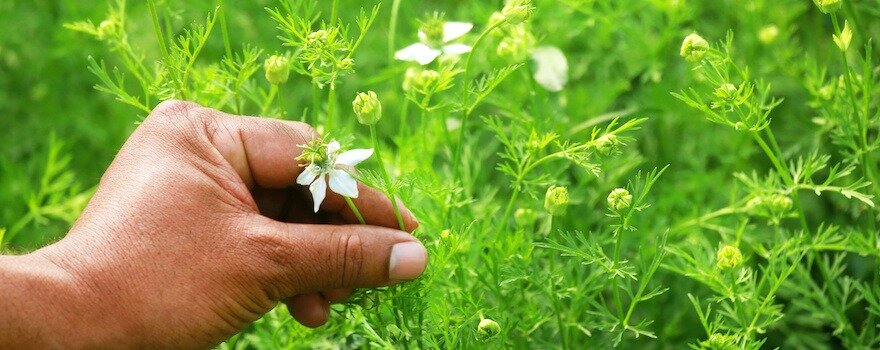
Studies and scientific research have shown that black cumin has multiple health benefits.
By positively affecting immunity and combating free radicals, it protects the body and prevents numerous diseases and infections.
But it is also anti-inflammatory, antibacterial, improves diabetes, and relieves skin conditions.
Nutritional composition
- Amino acids
- Vitamins: provitamin A, B1, B2, B3, B6, B9, C, E
- Minerals and trace elements: potassium, calcium, phosphorus, magnesium, sodium, iron, copper, selenium, zinc
- Proteins
- Lipids
- Carbohydrates
- Fiber
- Active compounds: thymoquinone, thymohydroquinone, dithymoquinone, thymol, nigellone
- Alkaloids
- Saponins
- Fatty acids: omega-6-9
- Tannins
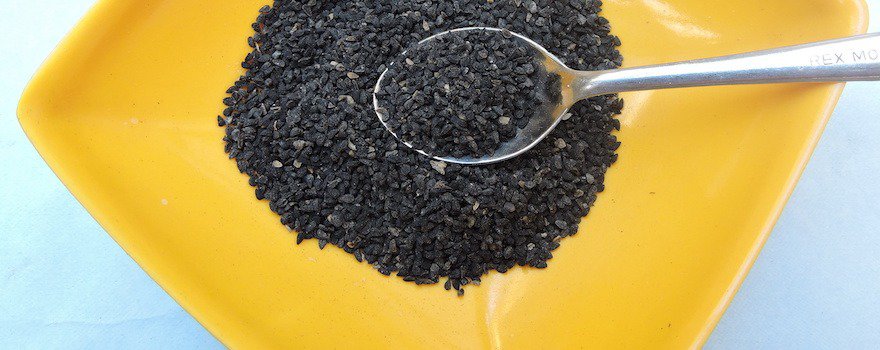
The benefits of black cumin
🛡 Protects and stimulates the body
Black cumin is a great protector of the body. On one hand, it stimulates the immune system and boosts the production of natural defenses; on the other hand, it is antioxidant and fights free radicals that weaken the body.
Consumption of black cumin seeds is interesting to prevent numerous diseases and infections: flu, pharyngitis, bronchitis, allergies… It stimulates immune defenses such as T lymphocytes. It also boosts the activity of natural killer (NK) cells, which help control bacterial infections and destroy cancerous cells.
Black cumin is also effective in regulating the body’s reactions in the case of immune disorders: vitiligo, allergic rhinitis, asthma, celiac disease…
Finally, it is an antioxidant plant: it fights free radicals that damage cells, accelerate aging, and promote the onset of diseases.
These various properties are due to a powerful active principle found in black cumin: thymoquinone. It has immunomodulatory, antioxidant effects and is capable of protecting the body’s various organs. It traps free radicals while preserving the activity of various antioxidant enzymes such as catalase and glutathione peroxidase.
This review from the American University of Sharjah (United Arab Emirates) presents the immunomodulatory action of black cumin.
This other review from Naturoveda India explored the beneficial effects of black cumin on immune disorders.
🌵 Reduces inflammation
Black cumin has a strong therapeutic potential in the treatment of various inflammatory diseases. It has proven effective in reducing inflammation in cases of periodontitis (inflammation of the tissue surrounding the teeth), rheumatoid arthritis, osteoporosis, osteoarthritis or Alzheimer’s disease, characterized by inflammation in the brain.
Again, it is thymoquinone that is responsible for these effects. On one hand, it inhibits the action of interleukin 1 (IL-1) and interleukin-6 (IL-6), the main pro-inflammatory cytokines in the body. Additionally, it acts on the nuclear transcription factor κB (NF-κB) involved in the inflammation response. Finally, thymoquinone reduces the synthesis of prostaglandins and leukotrienes, the main mediators of inflammation.
Nigella also has analgesic effects. This allows it to relieve acute or chronic pain associated with inflammation such as joint pain.
This study from the Isfahan University of Medical Sciences (Iran), conducted on mice, shows the analgesic and anti-inflammatory effects of nigella seeds.
This other study from Future University (Egypt), conducted on rats, shows how thymoquinone reduces brain inflammation involved in Alzheimer’s disease.
Finally, this study from the University of Health Sciences (Pakistan), conducted on rats, shows the efficacy of thymoquinone in alleviating rheumatoid arthritis through its anti-inflammatory action.
🦠 Fight against bacteria
Nigella exhibits exceptional antibacterial activity. Various studies conducted on the subject show that it can act on different types of bacteria: Bacillus, Listeria, Staphylococcus, Escherichia, and Salmonella.
The thymoquinone it contains exerts a bactericidal action: it is capable of inhibiting the development and proliferation of bacteria. It also prevents biofilm formation, a community of microbes and bacteria that covers mucous membranes.
This review from Mekelle University (Ethiopia) highlights, among others, the antibacterial activity of nigella.
This study from the University of Health Sciences (Pakistan), conducted on bacterial strains, shows the efficacy of nigella in destroying the Staphylococcus aureus bacteria.
Finally, this study from Kagawa University (Japan), conducted directly on bacterial cultures, demonstrates how thymoquinone prevents biofilm bacterial formation.
🍭 Improves diabetes
In the case of type 2 diabetes, nigella could lower blood sugar levels (glycemia) and reduce insulin resistance.
To achieve this, nigella employs various antidiabetic mechanisms. It increases endogenous antioxidants (naturally produced by the body), combats the overproduction of free radicals, and reduces inflammation generally associated with diabetes.
It also improves the lipid profile of diabetic individuals by increasing HDL-cholesterol (or “good cholesterol”) while reducing LDL-cholesterol (or “bad cholesterol”) as well as body weight. Consequently, it protects them from certain complications such as atherosclerosis and cardiovascular disorders.
This study from the University of Dammam (Saudi Arabia), conducted on patients with type 2 diabetes, demonstrates how nigella improves their lipid profile.
This other study from the Indian Institute of Medical Sciences (India), conducted on patients with insulin resistance syndrome, shows the beneficial effects of nigella.
🍑 Relieves skin diseases
Thanks to its anti-inflammatory, antibacterial, antifungal action, and richness in omega 6 and 9 fatty acids, nigella is beneficial for treating certain skin diseases such as eczema, psoriasis, and acne.
In cases of acne vulgaris, nigella notably reduces papules and pustules significantly. It also causes pigmentation and darkening of the skin in cases of vitiligo and limits the proliferation of psoriasis plaques, all without causing side effects. Lastly, it promotes and accelerates wound healing.
This plant also contributes to skin beauty and health by relieving irritation, improving hydration, and strengthening the protective barrier. It is increasingly used in anti-aging, moisturizing, soothing, and protective cosmetics.
This review from the University of Dammam (Saudi Arabia) presents the dermatological effects of nigella.
This other study from Bu-Ali Sina University (Iran), conducted on rats, shows how nigella promotes wound healing.
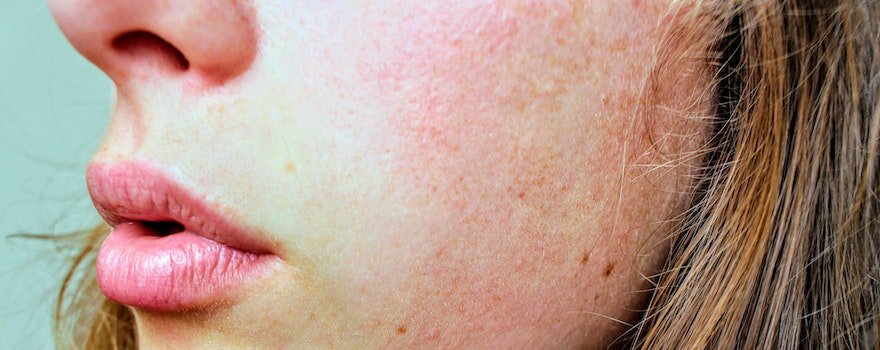
How to consume nigella?
Nigella seeds
Nigella seeds can be added whole or ground to savory and sweet recipes: raw vegetables, fruit salads, meat, fish or vegetable dishes, breads, and pastries… They will bring depth and a unique, spicy, lemony and slightly bitter flavor to your dishes. Nigella seeds can advantageously replace pepper in cooking and are easy to digest.
To preserve their virtues, be sure to add them at the end of cooking only. Beware of their pronounced taste!
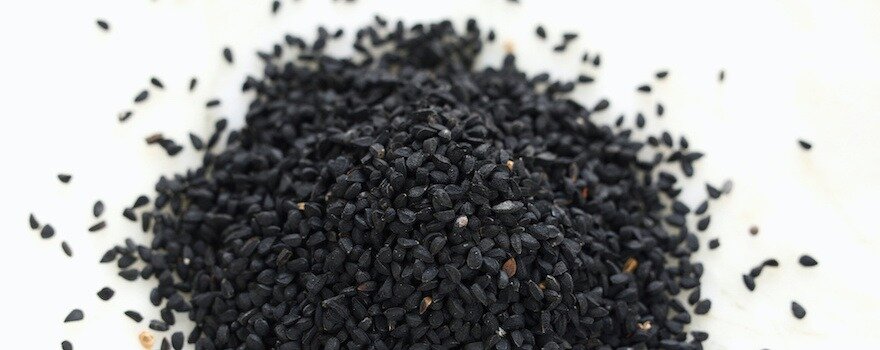
Nigella in tablets
Nigella is usually offered in capsules or softgels. Capsules contain nigella seed powder. Softgels, on the other hand, contain nigella seed oil. Indeed, like flax seeds, chia, pumpkin, or hemp, black cumin seeds are oilseeds: rich in fats, they are crushed and pressed to extract an oil which is then encapsulated.
To achieve good results, choose capsules or softgels with sufficient nigella dosage (500 mg/capsule minimum), preferably without additives and plant-based.
Nigella powder
Nigella powder is obtained by grinding the seeds. It can be used in cooking or prepared as a tea or infusion. Use 1 teaspoon of powder for a cup of hot water. Sweeten with a bit of honey or lucuma powder.
You can also add nigella powder to your cosmetics, facial and hair masks.
Choose a 100% pure powder, without additives, preservatives, or GMOs.
Nigella oil
Nigella oil is used externally as a cosmetic oil for massages and skincare. It can treat skin diseases, soothe burns, sunburns, irritations, and itchiness. It is particularly suited for dry, sensitive, and irritated skin.
You can apply it directly to the skin or add a few drops to your homemade cosmetic recipes or daily skincare. First, perform a patch test in the crook of your elbow as nigella oil is rich in essential oil. Be careful not to apply it on mucous membranes or around the eyes.
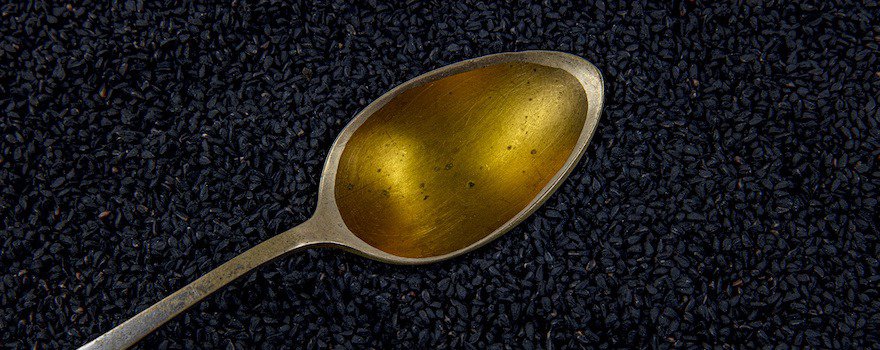
Nigella and medicinal plants
To reduce inflammation, it can be combined with other natural anti-inflammatories like turmeric, ginger, or boswellia.
Against skin problems, nigella vegetable oil pairs well with aloe vera, fenugreek oil, or rosehip, which protect and enhance skin beauty.
Consume sustainably: favor organic and fair-trade nigella
✓ Today, nigella is primarily cultivated in Africa, Turkey, Syria, and India. Ethiopia is a recognized and renowned country for the quality of its nigella seeds. This production provides an extra income for local farmers and contributes to the development of agricultural regions.
✓ Preferably choose organically grown seeds from fair trade.
Dosage
Although there is no recommended dosage for nigella, it should not be consumed in excessive amounts as it can be slightly toxic (but at very high doses of 25 g or more).
Capsules or softgels are preferably taken in the morning on an empty stomach, in the evening before bedtime, and 30 minutes before meals.
The ideal is to undertake 1 to 3-month courses.
🥄 Seeds: 500 mg per day
💊 Tablets: 2 per day for 500 mg capsules
🥄 Powder: 1 teaspoon morning and evening
🥃 Oil: 1 to 2 external applications per day
Contraindications and Side Effects
The consumption of nigella has certain contraindications :
- As a precaution, it is not recommended for pregnant or breastfeeding women and young children;
- People with a bleeding disorder or who are undergoing surgery should avoid consuming it ;
- Due to its action on blood pressure, it is not recommended for those suffering from low blood pressure.
The consumption of nigella has very few adverse effects. However, the following side effects may appear :
- Stomach pain
- Vomiting
- Constipation
If you experience side effects, stop consuming it and consult a doctor.
History, Culture, and Market of Nigella
Nigella has a rich historical background. Used as a spice in various culinary preparations, it was also a traditional remedy in Arab countries, the Far East, Europe, and Africa. Long considered a ‘miraculous’ plant, it was indicated to relieve many ailments : fever, cough, bronchitis, asthma, headaches, and migraines, gastrointestinal disorders…
It is also a key plant in prophetic medicine (as dictated by Muhammad) where it is considered as “a remedy for all diseases except death.”
Currently, more than 1000 studies have been conducted over the past 5 decades to discover the properties of nigella. But it continues to surprise us! New research highlights the potential of nigella seeds and thymoquinone in the fight against cancer.
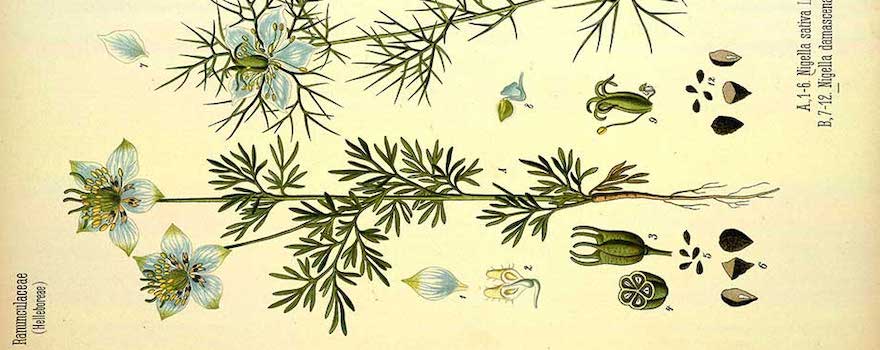
Report by Julia Perez and Charlotte Jean
Sources and Scientific Studies
Elham Nourbar, Naser Mirazi, Siamak Yari, Mahmoud Rafieian-Kopaei, and Hamid Nasri, 2019. Effect of Hydroethanolic Extract of Nigella sativa L. on Skin Wound Healing Process in Diabetic Male Rats.
Amin F Majdalawieh, Muneera W Fayyad, 2015. Immunomodulatory and anti-inflammatory action of Nigella sativa and thymoquinone: A comprehensive review.
Aftab Alam Hossain, Naturoveda India Pvt. Ltd. Kolkata, Khalid Md Saifullah, 2019. The Effects of Nigella Sativa on the Immune Disorders.
Alireza Ghannadi, Valiollah Hajhashemi, Hadi Jafarabadi, 2005. An investigation of the analgesic and anti-inflammatory effects of Nigella sativa seed polyphenols.
Y S Abulfadl, N N El-Maraghy, Aa Eissa Ahmed, S Nofal, Y Abdel-Mottaleb, O A Badary, 2018. Thymoquinone alleviates the experimentally induced Alzheimer’s disease inflammation by modulation of TLRs signaling.
Sabeen Arjumand, Muhammad Shahzad, Arham Shabbir, Muhammad Zubair Yousaf, 2019. Thymoquinone attenuates rheumatoid arthritis by downregulating TLR2, TLR4, TNF-α, IL-1, and NFκB expression levels.
Ebrahim M. Yimer, Kald Beshir Tuem, Aman Karim, Najeeb Ur-Rehman, and Farooq Anwar, 2019. Nigella sativa L. (Black Cumin): A Promising Natural Remedy for Wide Range of Illnesses.
Abdul Hannan, Sidrah Saleem, Saadia Chaudhary, Muhammad Barkaat, Muhammad Usman Arshad, 2008. Antibacterial activity of Nigella sativa against clinical isolates of methicillin-resistant Staphylococcus aureus.
Ayano Tada, Haruyuki Nakayama-Imaohji, Hisashi Yamasaki, Miad Elahi, Tamiko Nagao, Hirofumi Yagi, Masao Ishikawa, Koji Shibuya, Tomomi Kuwahara, 2020. Effect of thymoquinone on Fusobacterium nucleatum‑associated biofilm and inflammation.
Huda Kaatabi, Abdullah O Bamosa, Fatma M Lebda, Abdulmohsen H Al Elq, Ali I Al-Sultan, 2012. Favorable impact of Nigella sativa seeds on lipid profile in type 2 diabetic patients.
Ahmad Najmi, Mohammad Nasiruddin, Rahat Ali Khan, Shahzad F Haque, 2008. Effect of Nigella sativa oil on various clinical and biochemical parameters of insulin resistance syndrome.
Salih H.M.Aljabre, Omar M.Alakloby, Mohammad A.Randhawab, 2015. Dermatological effects of Nigella sativa.
Elham Nourbar, Naser Mirazi, Siamak Yari, Mahmoud Rafieian-Kopaei, and Hamid Nasri, 2019. Effect of Hydroethanolic Extract of Nigella sativa L. on Skin Wound Healing Process in Diabetic Male Rats.
Mohammad Tariq, 2008. Sativa Seeds: Folklore Treatment in Modern Day Medicine.
Hira Ijaz, Ume Ruqia Tulain, Junaid Qureshi, Zeeshan Danish, Samina Musayab, Muhammad Furqan Akhtar, Ammara Saleem, Khanzada Khan, Muhammad Zaman, Imran Waheed, Imran Khan, Mohamed Abdel-Daim, 2017. Review: Nigella sativa (Prophetic Medicine): A Review.
Hamid Mollazadeh, Amir R Afshari, Hossein Hosseinzadeh, 2017. Review on the Potential Therapeutic Roles of Nigella sativa in the Treatment of Patients with Cancer: Involvement of Apoptosis: – Black cumin and cancer.


